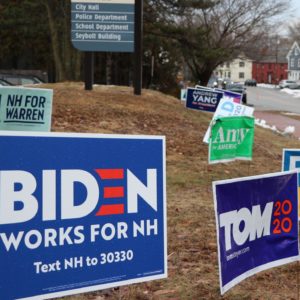Despite months of intense campaigning and a field of candidates featuring three high-profile New England politicians, turnout in the Democrats’ 2020 #FITN primary actually fell compared to 2008. It’s a trend that extends across the first three contests of the 2020 cycle, one that has national Democrats worried.
Post-primary headlines trumpeted the raw turnout number as a new record, and it was. The 298,433 votes cast in the 2020 New Hampshire Democratic primary were the most ever, breaking the 2008 record of 288,672, the NH Secretary of State reports.
But there were also more registered voters in the Granite State on Election Day 2020 (1,018,783) than in 2008 (980,720). More significantly, the pool of potential Democratic primary voters was also larger in 2020 than when Barack Obama narrowly lost to Hillary Clinton in New Hampshire.
The key stat: In 2008, 47 percent of potential Democratic primary voters (registered Democrats and non-affiliated voters) participated in their primary, while this year just 42 percent pulled Democratic ballots — a 10 percent drop.
This trend has been relatively constant across the three contests thus far. “I think we’ll see our biggest turnout that we’ve ever seen,” predicted then Iowa Democratic Party chairman Troy Price before the Iowa caucus. Instead, just 176,000—well below the historic 2008 number of 240,000 — turned out. In Nevada, only 17.2 percent of active registered Democrats participated in the caucus, despite the addition of early voting. According to the Reno Gazette-Journal, in 2008 it was closer to 25 percent.
“Am I worried about it? Yeah,” Obama advisor David Axelrod told the Daily Beast. He worries that slumping turnout may be a sign the Democratic base “just felt dispirited.”
“That’s a danger for Democrats,” Axelrod continued. “The Trump effort is infused with cynicism. And propagating cynicism can be a powerful tactic if you’re trying to depress an opponent’s turnout. That is a big concern that a dispirited electorate, beaten and burnt out, just walks away.”
Unfortunately for Axelrod and the Democrats, the numbers are even worse than they first appear. In 2008, there were only two candidates on the Democratic ballot, not the nearly 20 candidates who spent time and money on get-out-the-vote efforts.
And in 2008, Democrats had to compete with Republicans for unaffiliated voters. GOP candidate Sen. John McCain explicitly appealed to independent voters to back his candidacy in his party’s competitive primary, pulling away potential Democratic primary voters.
Plus…Trump. Democrats didn’t have a Donald Trump to run against in 2008. In fact, Trump was a Democrat in 2008, and a major donor to the party. Today, Democrats have their animosity toward Trump to help drive turnout up.
It worked in the #BlueWave election of 218. Where is it today?
Some have speculated that Trump hatred is actually encouraging Democratic primary voters to stay home. They’re so committed to voting Trump out of office that they don’t care which candidate wins the primary, the theory goes.
That’s possible, but unlikely. If voters are engaged with a candidate, they want to turn out and show their support, whether their vote matters directly or not. The perfect example is Donald Trump himself.
He’s set real turnout records for an incumbent president in both Iowa and New Hampshire. In the Granite State, 113,969 Republicans (plus nearly 40,000 undeclared voters) turned out to vote in a meaningless GOP primary in which President Trump faced token opposition. That’s 37 percent registered GOP turnout, in an effort that amounted to nothing more than mere cheerleading for their president.
“Impeachment has lit a fire under the Trump base — and I anticipate it will burn until Election Day in November,” former Minnesota Sen. Norm Coleman told Politico.
Bernie Sanders’ theory of the 2020 race is that his supporters will swarm the polls, a mass of young voters and voters of color that will bring about revolutionary change as they storm the polling places. So far, that doesn’t appear to be the case. It’s true, as WMUR reports, that turnout in some college towns was up, but it wasn’t enough to close the gap with 2008.
The news for New Hampshire Democrats isn’t all bad. For the first time in a decade, there are more registered Democrats (324,593) than Republicans (306,542).
But that doesn’t do much good if they don’t show up.

